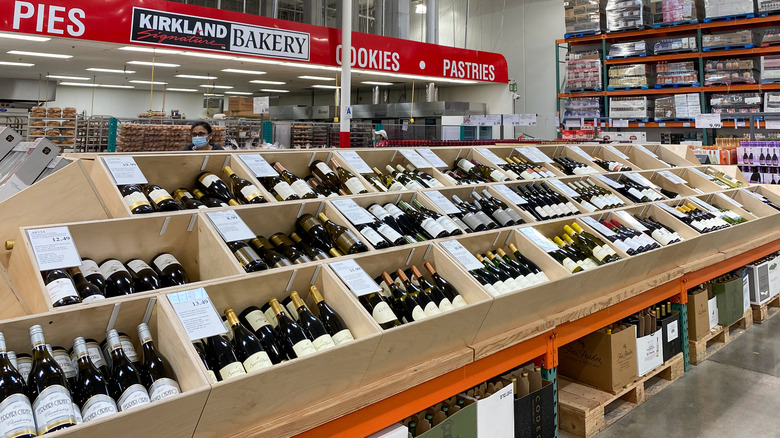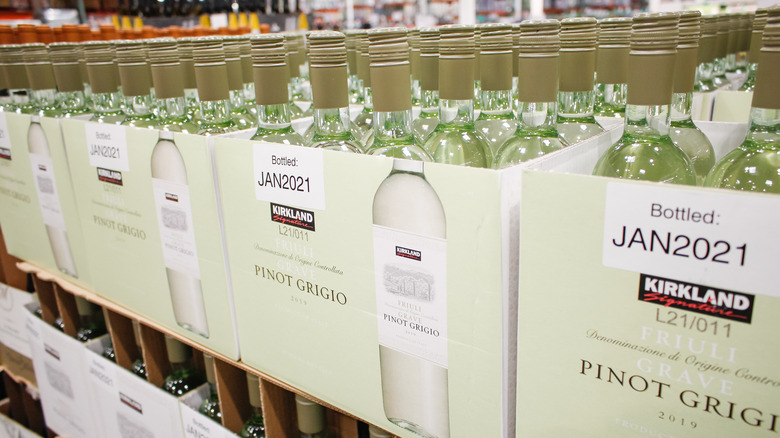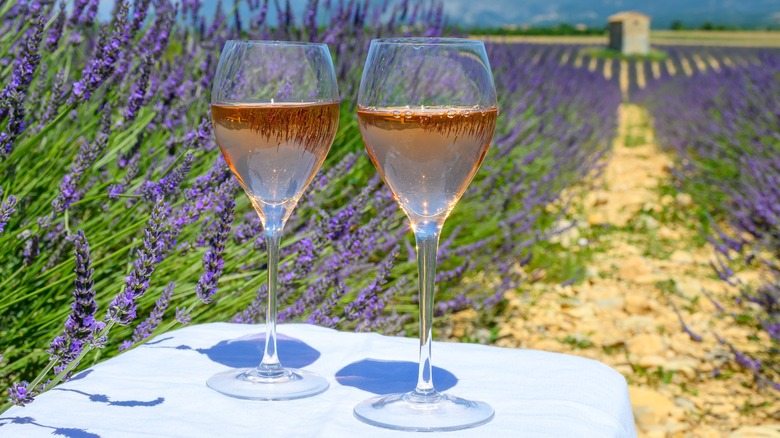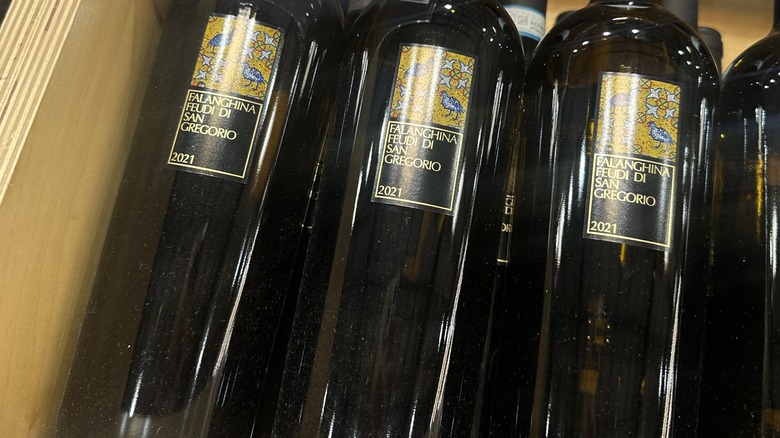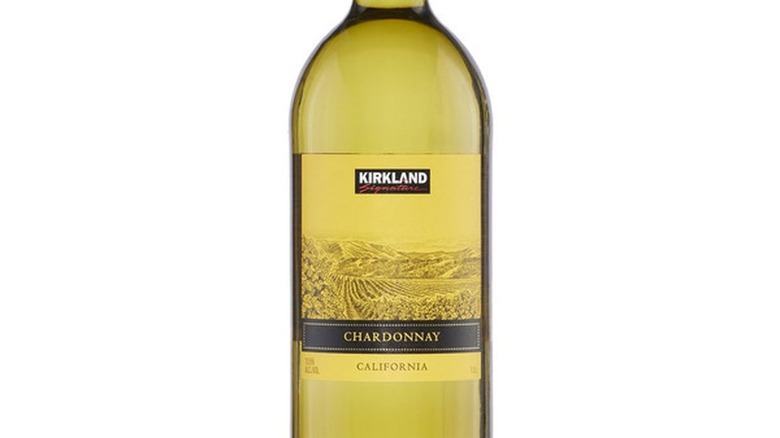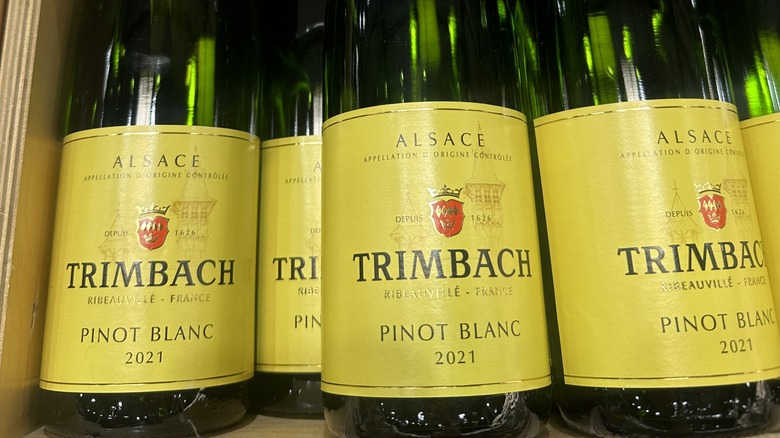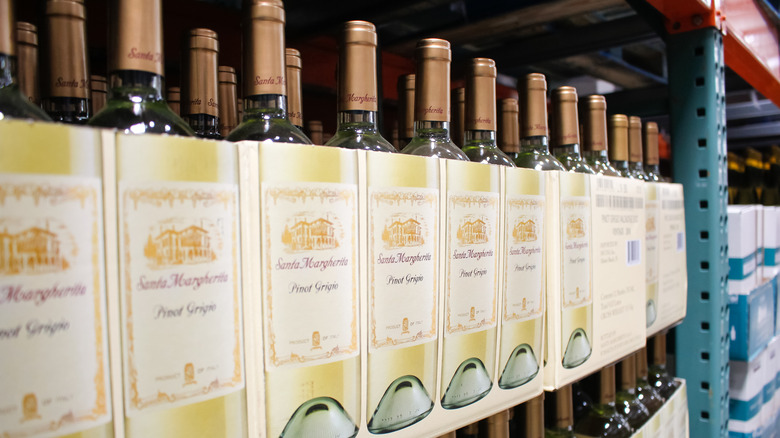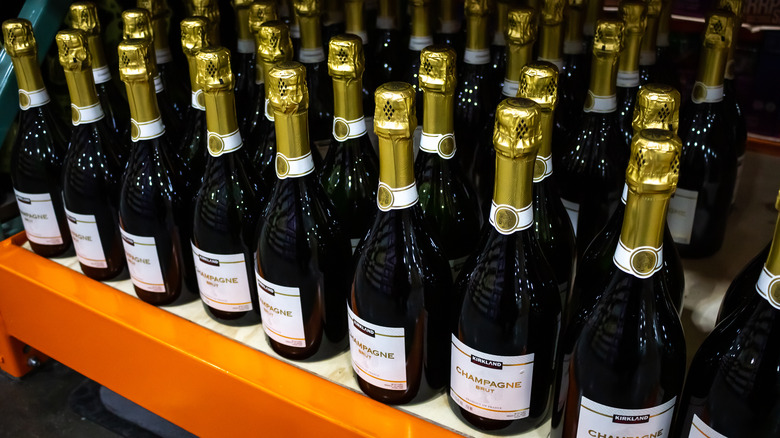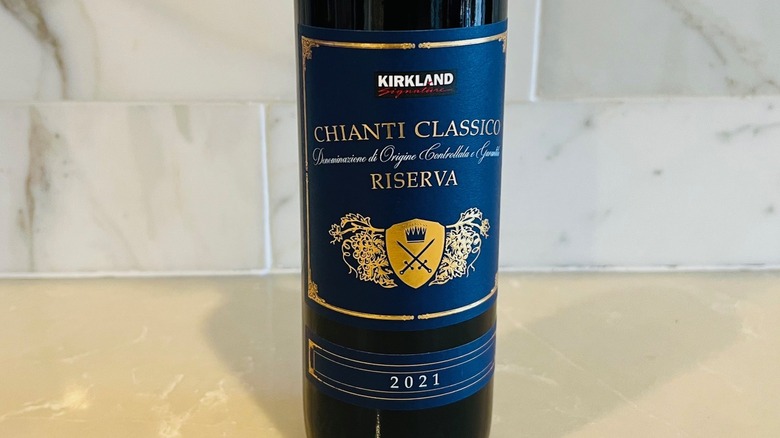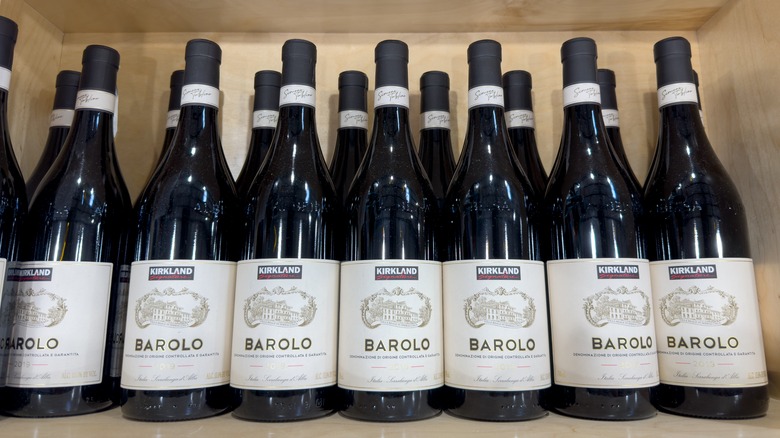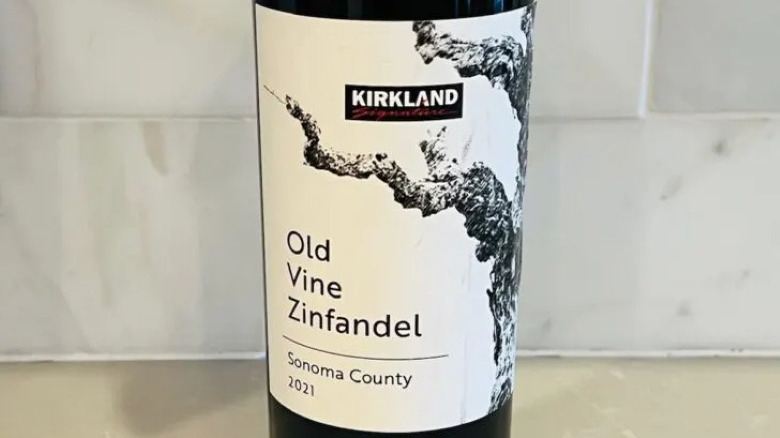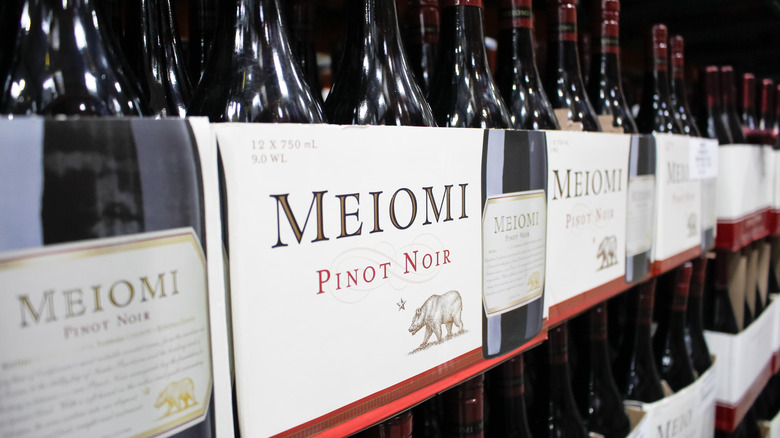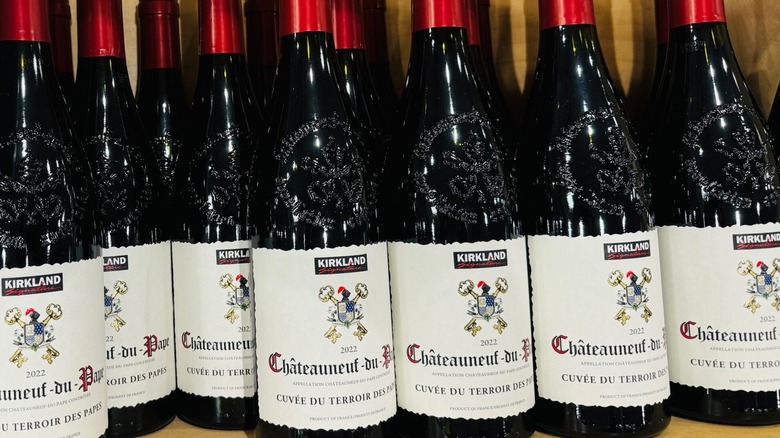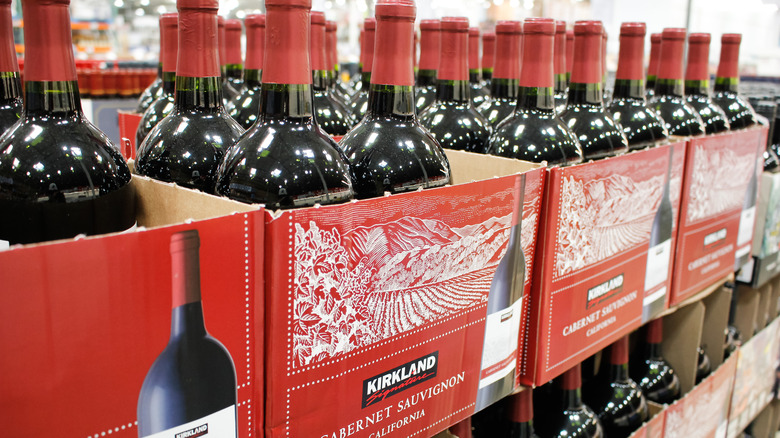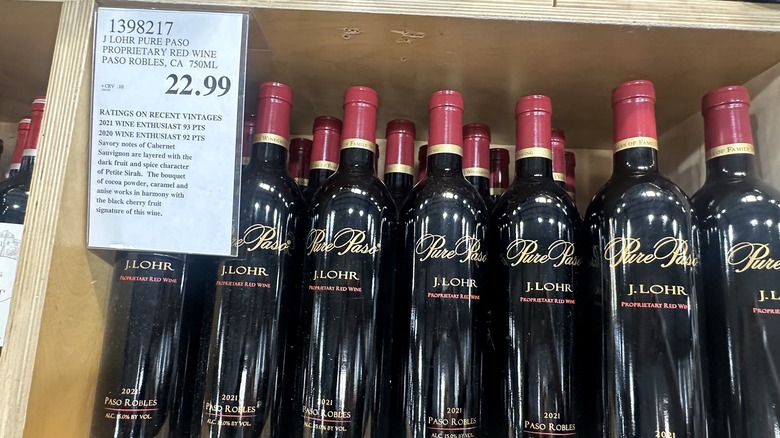The Best And Worst Bargain Wines To Buy At Costco
As a wine writer and consultant, wine regularly arrives on my doorstep as press samples or wines from clients I am working with. I am one of those annoying people on social media, posting photos of myself with glasses of gorgeous wines in some of the most sought out wine regions in the world, with captions like, "It's a tough job, but someone's gotta do it." Needless to say, when I complain about work, I don't get a ton of sympathy. But, being a wine professional is more grueling than it sounds. Let's just say tasting 50 different California Cabernet Sauvignons back-to-back before 10 a.m. while judging a wine competition is nothing short of exhausting.
I also sometimes miss the simple joy of walking up and down the aisles of a wine store, perusing the latest releases and choosing wines just for me. In addition to the many independent wine shops out there, one of the top spots to do this is Costco. Costco is among the largest wine retailers by volume in the United States, and carries selections from some of the top names in wine. They also partner with world-renown producers for their Kirkland Signature line, which includes some of the best buys you can find. Since I'm clearly a glutton for punishment when it comes to wine, for this round-up, I did the hard work for you and went through them all to create a list of some of the best and worst bargain wines to buy at Costco.
Best: Kirkland Signature Pinot Grigio Friuli
Pinot Grigio is one of those wines that can be boring and insipid or complex and spectacular, depending on where it's from and how it's produced. The grape is grown throughout the world, with some of the top expressions of it found in parts of Northern Italy. Kirkland's Pinot Grigio comes from Friuli Venezia Giula, a small area in northeastern Italy, bordering Slovenia and Austria that produces more white wines than reds. White wines here are usually lean, crisp, and high in mouth-watering acidity, and this Pinot Grigio is no exception.
I love to keep a few bottles of this on-hand at all times as my house white wine. It's light and simple but super easy-drinking and lower in alcohol, which makes it a great porch pounder or poolside sipper. Costco offers this for about $5 a bottle, whereas other entry level selections from this region are around twice that, so stock up on a case or two for the warm weather season ... or, like me, year-round.
Worst: Kirkland Signature Côtes de Provence
While on the topic of porch-pounders and poolside sippers, Costco's Kirkland Signature Côtes de Provence rosé comes close to hitting the mark in this category, but may lean a little too hard into its simplicity. The current vintage of Kirkland's Côtes de Provence is a blend of mostly Grenache, Cinsault, and Syrah, which are classic grapes for making this type of rosé. According to the bottle, it's made by Olivier Sumeire, a seventh generation grape grower and winemaker whose family has been producing wines in Provence since the 13th century.
Where it delivers is on the $7 per bottle price point, which, for this particular region in France, is quite a steal. However, while I normally love the light, quaffable nature of a Côtes de Provence — the ultimate picnic wine — I still expect a bit more oomph than this one offers. It's a pleasant enough sip, but save this one for a quick apéritif instead of your centerpiece wine.
Best: Feudi di San Gregorio Falanghina
This is a serious wine from one of the top producers in Southern Italy at an absolute steal of a price. While not a Kirkland brand wine, I've seen it available at most Costco locations for $14.99. While Falanghina may be tough to pronounce, it's a grape you should get to know, especially if you love crisp white wines like Pinot Grigio, Sauvignon Blanc, and Albariño. With a price point under $15, it's not even a risk to give this offbeat wine a try.
Falanghina is native to the region of Campania, and known for its high acidity, which makes it great for a wide variety of styles of wine, from steely, unoaked sippers to wines aged in barrel, and even sparkling and dessert selections. This particular bottling spends five months aging in stainless steel tanks on its lees — those yeast cells that fall to the bottom of the tank during fermentation, and provide a creamy, textured mouthfeel when kept in contact with a wine as it ages. The result? A crisp, mouth-watering white wine packed with lime zest, white flower blossoms, green apple, and stone fruit. It's the perfect dinner white wine, especially paired with seafood, a selection of soft cheeses, and grilled vegetables.
Worst: Kirkland Signature California Chardonnay
If a butter bomb is your style of Chardonnay, then maybe this Kirkland Signature selection, available in hefty 1.5-liter bottles, will be right up your alley. Over the top with tropical fruit, vanilla, and a sweet, buttered popcorn Jelly Belly note, this is a pretty full-bodied wine that would likely benefit from a backbone of acidity to offset the heavy flavors.
I'm a firm believer that there is a wine for everyone — including this one. According to Park Street, Chardonnay is the most consumed grape variety for table wine in the United States. Any comprehensive guide to Chardonnay will also tell you it's grown all over the world, and is one of the most versatile grapes for wine production, resulting in bright, fruit-driven wines and zippy sparklers like Champagne, to high-acid wines full of minerality, like the wines of Chablis, to voluptuous and round selections, like this Kirkland Signature Chardonnay. This means there are plenty of far more exciting selections of this variety available at Costco that, for a few more bucks, offer a more balanced oak profile with some freshness to liven up the wine. I'd recommend checking some of those out first. Costco's Kirkland Signature Sonoma Coast Chardonnay or Sonoma-Cutrer's Chardonnay are great places to start.
Best: Trimbach Pinot Blanc
Alsace, in the northeastern part of France, near the German border, is hands-down one of my favorite wine regions in the world, thanks to its diverse range of really exciting white wines of all styles, and its bright, juicy, reds that beg to be sipped alongside any number of dishes.
Pinot Blanc shines in this region, known for its aromatic white wines, like Muscat, Riesling, Gewürztraminer, Sylvaner, and Pinot Gris, and Trimbach's take on the grape is no exception. In general, it's a friendly, easy-drinking wine, with just the right mix of fruit, freshness, and body. "Wine connoisseurs often describe me like a gently swinging song, taking life as it comes!" notes the trade organization Vins Alsace, ever so poetically. "I'm as supple as an acrobat who always lands on his feet, regardless of the dishes offered up to me. In short, I'm perfectly charming and poised."
The Trimbach Pinot Blanc is luscious and concentrated, with succulent fruit and freshness, making it a perfect food wine or delicious on its own. Its $15.99 price tag at Costco is a steal, so don't sleep on this fun grape variety from an exciting region. And, when you're done shopping for the wine, be sure to check out this beginner's guide to Alsatian wine, as it's a destination worth exploring beyond the store shelves of Costco.
Worst: Santa Margherita Pinot Grigio
Like Friuli Venezia Giulia, Northern Italy's Alto Adige — where Santa Margherita's Pinot Grigio hails from — is also celebrated for its top-quality Pinot Grigio wines. Santa Margherita is indeed a good wine. But, it's nothing remarkable, and not worth the $18-ish price tag, even at Costco.
In fact, Santa Margherita Pinot Grigio has long been the source of debate among wine professionals for its questionable quality-price ratio. Celebrated husband-wife wine writing duo Dorothy J. Gaiter and John Brecher, in a 2009 Wall Street Journal article "10 Ways to Save Money Ordering," advise readers to avoid this wine like the plague. "Never order Santa Margherita Pinot Grigio," they write. "We don't mean to pick on Santa Margherita. We know many people like it and that's fine. But because so many people like it, it is routinely one of the most outrageously priced wines on the list."
Bottom line: As common economics will tell you, sometimes price is not indicative of quality, but instead of high demand. This is the case with Santa Margherita Pinot Grigio, which will have you reaching for it assuming it's a better wine than, say, the $5 Kirkland Signature Pinot Grigio from Friuli, and ending up disappointed that it's not at least three times better. I assure you it is not.
Best: Kirkland Signature Champagne Brut
There are few bigger bargains in wine than the Kirkland Signature Champagne Brut. This bubbly is made by well-known Champagne producer Manuel Janisson. It's a blend of Chardonnay, Pinot Noir, and Pinot Meunier grapes from the top vineyards in Verzenay, which just so happens to be one of the 17 Grand Cru villages in Champagne. In addition to its impressive pedigree and $19.99 price tag, it's also delicious. It boasts all those classic toasted brioche notes of Champagne, along with citrus, pear, and stone-fruit flavors, teensy bubbles, and an endless finish.
This fizz is the perfect apéritif, celebratory sip, or accompaniment to just about any cuisine. Sure, it may not be as sexy as bringing out a bottle of Dom Perignon, but at this price, you can afford to pour more than one glass for your guests. Hey, maybe you can even try sabering a bottle for dramatic effect — at least you'd only be out $20 if you need a bit more practice.
Best: Kirkland Signature Chianti Classico Riserva
Any Chianti Classico Riserva must spend a minimum of 24 months aging before release, three of which must be in bottle. Additionally, the wine must be made from a minimum of 80% Sangiovese grapes from a delineated area in the Chianti Classico region of Tuscany in central Italy. So, at $8.99, this wine is a total bargain when you consider where the grapes come from and how much goes into producing it, not to mention how long the winery must wait to recoup any of the costs of making the wine.
Costco's Kirkland Signature Chianti Classico Riserva is so easy-drinking, I have contemplated making it my house red and serving it by the carafe on a table decked in red checkered tablecloths, Dean Martin's "That's Amore," playing on the speakers. However, it also carries some weight and structure, with grippy (yet important!) tannins, and some prominent acid, so it's best sipped alongside a meal — ideally of pasta or pizza, grilled meats and vegetables, or that classic Tuscan dish, Pappa al Pomodoro (aka tomato bread soup). Most brand name Chianti Classico Riservas start at around twice this price and go way up from there — so, house wine or not, I would buy this one by the case.
Worst: Kirkland Signature Barolo
Don't get me wrong. Any Barolo for under $60 is virtually unheard of, so to find one at Costco for $19.99 practically demands that you buy it by the case. And, Barolo is like pizza: Even when it's bad, it's still pretty good ... or however that saying goes.
This one is decent, but lacks the concentration and gravitas that many Barolos offer, and that are the driving force behind this Italian red wine's exalted status. My worry is that, while this wine is tasty enough, it's a wine that is in line with a sub-$20 price point, which may make it tough for the average consumer to want to spend often twice that much to experience what a truly transcendental Barolo can be like. My recommendation? Splurge on one of the many other name brand Barolos on offer at Costco, usually for pretty competitive prices, or double up on a couple of bottles of the Chianti Classico Riserva instead.
Best: Kirkland Signature Old Vine Zinfandel
Wines often boast on their labels that the grapes came from "old vines," but what does this really mean? As grape vines age, a few things happen: First, the vines dig deeper and deeper into the soil, building more complex rooting systems as they go. As they continue to penetrate the earth, they pass through different layers of soil and, as a result, absorb many different types of substances in the earth than what they would going through shallow layers of soil. Secondly, old vines produce lower yields of fruit which means all of the soil nutrients and energy of the plant goes into fewer bunches of grapes. The combination of these two factors means greater complexity and concentration of flavors, two things we look for when analyzing quality in wine.
Wines produced from old vines can be intense, serious wines, and often carry a price tag to match, so to see one for under $10 is remarkable. Fans of classic California Zinfandel will love the rich, jammy-but-not-cloying quality of this Sonoma County wine, which is produced from vines averaging 45 years by longtime winemaker Zach Long.
Worst: Meiomi Pinot Noir
I tasted this wine at an event and had to double check the bottle to verify that it was indeed Pinot Noir. I suppose fans of sweet red wines may enjoy this selection, but true lovers of Pinot Noir will likely have trouble getting past the whopping 20 grams of residual sugar in this wine (for context, wines considered "dry" generally have less than 10 grams per liter of residual sugar), as well as its one-dimensional flavor.
While there's plenty to know about Pinot Noir, one key characteristic is that it's generally quite delicate and nuanced, with distinct flavors and aromas that Meiomi's bottling lacks entirely. In the words of Paul Giamatti's character Miles in the movie "Sideways," "... I mean, oh, its flavors, they're just the most haunting and brilliant and thrilling and subtle and ancient on the planet." While this sentiment may go beyond the average wine drinker's sensory lexicon, Miles makes a key point — true Pinot Noir should offer much more than just jammy fruit and sweetness.
If it's a great example of Pinot Noir you're after, Costco offers plenty of delicious options, from the Kirkland Signature selections from the Willamette Valley in Oregon and the Russian River Valley in Sonoma — both excellent regions for growing Pinot Noir — as well as bottlings from great producers like Imagery in Monterey and Loveblock in New Zealand. They may be a tad more expensive than the Meiomi, but all will more than deliver on the magic in your glass.
Best: Kirkland Signature Châteauneuf-du-Pape
While Kirkland Signature wines are all made by well-known figures in winemaking around the world, it's often somewhat of a secret which wineries and producers were involved in which selections. However, some bottles do include more information about the specific producer, like Kirkland's delicious Châteauneuf-du-Pape from the southern part of France's Rhône Valley.
This wine — a Grenache dominant blend with some Syrah, Mourvèdre, and Cinsault — was made by third generation winemaker Guillaume Gonnet, who has owned his family's estate in Châteauneuf-du-Pape since 2006. These wines are typically quite expensive — usually starting in the mid-$30 range and going up from there — and celebrated for their body, complexity, and age-worthiness. This bottling punches way above its weight class at the incredible bargain price of $19.69. It's packed with dark berry fruit, black licorice, and spice, with beautiful texture and a finish for days. Pop a bottle or two at your next dinner party, or lay it down for years to come so you can see it continue to evolve as it ages. Either way, the wine won't disappoint.
Worst: Kirkland Signature California Cabernet Sauvignon
Be sure not to confuse this wine with other Kirkland Signature Selection Cabernet Sauvignons. You'll recognize this one for the 1.5-liter bottles and 3.5-liter boxes it comes in. Like its cousin, the Kirkland Signature California Chardonnay, this California Cabernet Sauvignon is decent enough — Wine Enthusiast even gave it 88 points! — but hardly remarkable. It's got lots of dark berry, plum, and oak-driven flavors like cinnamon and vanilla, but still tastes somewhat artificial, even medicinal. At $8 for a 1.5-liter bottle it's certainly a bargain price, but you get what you pay for in terms of the complexity, structure, and concentration we would expect from a more serious bottle of Cabernet Sauvignon.
Personally, I would save this wine for cooking or serving to large groups on a tight budget. Or, I would recommend whipping up a big batch of refreshing red sangria to serve at your next backyard barbecue. If it's a more elegant expression of Cabernet Sauvignon that you're after, Costco has plenty of affordable choices from California, like their Kirkland Signature appellation-specific series from Napa Valley and Alexander Valley, as well as selections from exciting regions like Red Mountain and Columbia Valley in Washington State.
Best: J. Lohr Pure Paso Proprietary Red Wine
J. Lohr is always reliable for great quality wines at reasonable prices. You're likely used to seeing the ubiquitous J. Lohr Seven Oaks Cabernet Sauvignon at your local grocery store, which is many people's go-to when purchasing an easy-going red wine to please a crowd. The Pure Paso Proprietary Red Blend is a few steps up, and worth exploring if you are a fan of ripe, full bodied red wines.
Although "proprietary," the breakdown of the blend is listed on the J. Lohr website, and comprises mainly Cabernet Sauvignon and Petite Sirah, a powerful duo to begin with. The wine then spends 18 months in American and Hungarian oak, which gives it delicious notes of sweet black licorice, mocha, and caramel layered over the wine's black and red fruit flavors. This is a top-scoring wine from several critics and a fantastic choice for those who love California red blends. The region of Paso Robles often presents great value in this category and, for a mere $22.99 a bottle at Costco (by comparison, my local grocery store had this listed for about $32), J. Lohr's Pure Paso Proprietary Red is no exception. Expect it to give any wine from its much pricier Northern California neighbors a run for its money.
